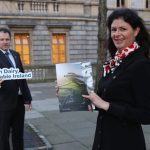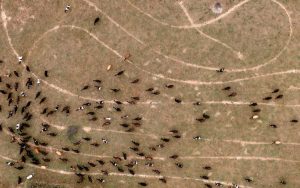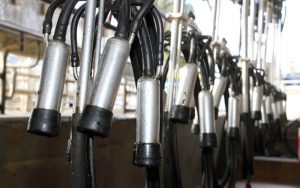
For many, Auckland’s water restrictions have meant little change to their daily lives. Turning off the tap while brushing your teeth, or cutting short your shower. But for dairy farmer Robert Cashmore, it’s put a strain on his livelihood.
The dairy farmer, based in Waiapa, south of Auckland, is anticipating a $180,000 financial hit as a result of Auckland’s unprecedented drought, which saw his farm receive only 650ml of rain this year – around half what is normal.
As a result of his bare, dry paddocks, Cashmore was forced to sell 150 cows from his herd of 300, and 300 of his 2500-strong flock of sheep, due to not having enough grass to feed them. The alternative, he feared, was that they would give birth to new offspring and die due to being underweight.
“It’s been utterly annihilating, an absolute nightmare. The whole year has basically been a write-off.”
“The hillsides and paddocks are bare, and we had to sell half of our cows in May,” Cashmore said.
As well as the financial hit, dealing with the drought had been “immensely stressful”, and had taken a toll on his mental health.
“I was going stir crazy in July and August, but I’m very lucky to have an understanding wife,” he said.
“She could tell I was getting really wound up, so she told me to go on a fishing trip and take some time off the farm.”
The sentiment was echoed by Federation Farmers president Alan Cole who says the mental health struggles brought on by the drought were very real, and there had been a spike in people reaching out for help this year.
“Rural Support Trust has received an increase in phone calls for this time of year than they generally would, and that’s just an ongoing effect of the drought,” he says.
And Federation Farmers’ New-Season Farm Confidence Survey recorded a 25 per cent increase in Auckland farmers describing economic conditions as bad from January to July.
While the costs of running his farm increased throughout the drought due to having to buy extra feed, Cashmore says farmers typically sell their products at a fixed price, so he did not believe it would have a flow-on effect on grocery prices.
“But the drought does create more supply than demand, because a lot of farmers will sell stock they would usually hold on to,” he said.
“There was a peak over-supply from March to July, which leads the meat companies to generally drop their price because they have too much of one product.”
How it started
Brewing world pandemics aside, January 2020 was a pretty regular month in terms of summer heat.
Temperatures were “mostly near average” for the North Island but what was different, was the rainfall – or lack of it.
Parts of the upper North Island recorded less than 10 per cent of what is typical for that time of year, and northern Auckland, Great Barrier Island and southern Northland began experiencing a “severe meteorological drought”.
Despite this, Aucklanders went hard on the taps, and on January 31, they used 538 million litres of water – breaking the record of 535 million litres set on February 13, 2019, when parts of the region experienced a high of 28 degrees Celsius.
On February 4, that record was smashed again when residents used a whopping 561 million litres, much more than the average use of 440 million litres per day in 2019.
At the time, Auckland’s water storage levels at the Hūnua and Waitākere Ranges was sitting at 72 per cent full – less than the average of 83 per cent typical for the time of year.
While the region’s water company, Watercare, said it wasn’t hugely concerned by the falling stocks, it asked people to treat water as a precious resource and cut their showers to four minutes, in the hope of saving 80 million litres a day.
By February 15, Auckland had broken another record after experiencing 40 consecutive days with no rain, succeeding the record of 39 days set in 2013. But it was months before tighter restrictions were introduced.
A year of water restrictions
Outdoor hoses and water blasting devices were banned from May 16, and even Fire and Emergency NZ was asked to minimise its use of water for training purposes – a typical request when the supply of drinking water “is or may be at imminent risk”.
Exterior cleaning businesses also took a hit and had just a week to work out how they could continue to work around the restrictions.
Ben Sharp, co-owner of commercial exterior cleaning companies WashCo and @Height, which cleans tall buildings, struggled for a week to get hold of someone from Watercare to clarify how long the restrictions would continue.
He didn’t want to spend thousands of dollars on new equipment that would allow him to work through the restrictions if they were only going to last a month, he says.
Once it was established the restrictions would be in place for the foreseeable future, Sharp and co-owner Martin Wade spent about $60,000 on three trailer units, a truck with 1000-litre water tanks, high-pressure pumps, generators and a plumber to put it all together, that meant they could continue to work.
He says: “It sucked, but we did adapt. We realised this was going to hurt us financially, but we wanted to keep all our staff and our clients.”
The business partners were also conscious that clients may still be recovering from the financial impact of Covid-19, so they absorbed the costs rather than pass them on to customers.
Despite this, they suffered at least $100,000 worth of cancellations and deferrals from “big name clients” who didn’t want to be seen having their premises washed during a water shortage.
One of Sharp’s biggest gripes was the lack of communication with Watercare, as he would have liked the opportunity to demonstrate their ability to cut back on water use.
“We’re not dawdling around. We’re a company and our success is based on efficiency and productivity” he says.
Others in the industry also quickly learned they had to adapt to survive.
A group of exterior cleaning companies formed the Exterior Cleaning Industry Association shortly after the water restrictions were announced, to form a relationship with Watercare, share experiences and offer training on how companies could cut water use
Michelle Atwill, the association’s secretary and owner of Best Property Services, said no-one expected they wouldn’t be able to use hoses and water blasters entirely, instead assuming they would be given stricter water-saving targets.
She says Watercare later defined businesses such as hers as “low water users”.
“We are actually misunderstood with our water usage,” she said, adding that other industries used vast amounts of water behind closes doors.
The ECIA planned to arrange courses on water efficiency in 2021, where those who attended would be given “efficient operator cards”, which Atwill hoped would provide more certainty for Watercare and customers during any future water restrictions.
She also hoped the association would act as a communication channel between its members and Watercare, and vice versa, in instances when law changes could result in severe loss of business.
The restrictions, which saved about 40 million litres of water per day, remained untouched until October 12, when commercial water users were given the go ahead to use outdoor hoses providing they were fitted with a handheld trigger nozzle.
On December 14, the same liberty was given to all Auckland residents, due to saving targets being met and exceeded, more rainfall, and helped by the securement of new water supplies, including from the Hickey Springs Bores in Pukekohe, which were rebooted in October adding five million litres per day.
People were ‘flipping desperate’
The dry spell also spelled trouble for more than 20,000 rural residents who rely on tank water.
Some faced a two-month wait for water deliveries when their tanks dried up, and replacement supplies were lacking.
Kaukapakapa resident Duran Callaghan said the need for water was dire last summer, especially after Watercare temporarily shut down the Wellsford and Helensville water filling stations due to exceptionally high demand and low reservoir levels. The Warkworth station was also forced to close after a water main burst.
The closure put pressure on the nearby Silverdale, Massey, and Albany stations, which were flowing at a third of the usual rate, as the majority of north Auckland’s water delivery companies desperately tried to keep up with demand.
Callaghan knew of people who paid around $1000 to get onto an emergency water delivery list, but still faced a four-week wait.
“It [water] became even more scarce. People were getting flipping desperate,” he says.
Callaghan considers himself lucky, as he was able to take water from a tank at his workshop across the road. But even then, he was careful to use as little water as possible.
When his tank became critically low, he washed by splashing himself quickly under the shower before turning it off, lathering himself with soap, followed by another quick blast of the shower to rinse.
“It restricts your lifestyle quite a bit having to be very, very conservative.”
Callaghan, a sandblaster who works outdoors, is already noticing this summer’s heat and has “huge concerns” for the future, given how severe the drought was earlier this year.
“It was a very long stretch before we actually got some decent rain,” he says.
So what’s the long term solution?
More investment in infrastructure and new technologies, according to Watercare’s acting chief executive Marlon Bridge.
Bridge took over running the company after the resignation of CEO Raveen Jaduram in October, amid long-running political wranglings over his $775,000 salary, which made him the highest-paid chief executive in the council group.
Jaduram said he always planned to leave the role after six years but his decision to go in the midst of the region’s worst water supply crisis’ raised eyebrows.
Looking ahead, Bridge says a shift away from emptying wastewater into rivers and lakes, and innovative alternatives, such as recycling water, are on the horizon as way to tackle future water supply problems.
“At some point we’re going to have to put a peg in the sand to say, maybe not this generation but the next has to move forward in a direction that takes us away from what we’re doing today,” he says.
“That’s if we’re to be respectful of what we need to do in terms of minimising our impact on the environment.”
Solutions will come at a cost
But that shift will come at a cost to Aucklanders who will inevitably see their bills rise.
“Auckland Council is nearing its debt ceiling limit, and when you can’t borrow you’ve only got one other Avenue of funding, which is increasing prices,” Bridge says.
“We mitigate that by creating financial efficiency, and consideration needs to be given to longer term investment vehicles, which would be easier price increases for customers to handle rather than jolty short term price spikes.”
Overseas, desalination – the process of transforming seawater into a drinking water – is being applied in places such as Western Australia.
But the idea has already been dismissed as a possibility in Auckland, because the process is very expensive and not in line with the region’s climate change goals.
“A [desalination] plant to service the North Shore would cost around $2 billion,” Bridge says.
“The technology is getting cheaper, but we have to consider whether the public is comfortable undertaking a process as environmentally unfriendly as desalination.”
Recycling water is another strategy utilised by countries such as Singapore, which involves treating wastewater so it is drinkable – something Bridge says he’s open to in the long term.
“Recycling is getting a lot of cheaper, I think it’s more of a societal issue, the thought of people digesting something that they’ve created in the past doesn’t appeal to a lot of people,” he says.
“But if you’re really looking for a diversified portfolio, I can see a pathway for recycling, we may potentially need it in the future.”
Keeping up with demand in a growing city
AUT University professor of construction engineering John Tookey says recycling water requires ongoing financial investment, and having an abundant source of water can lead the public to be more wasteful.
“We need to think in terms of making better use of what we have through improved management, like reducing wastage from leaks, and education,” he says.
Tookey supports Watercare’s effort to moderate water use through restrictions, but says the region may need to look at other sources of water going forward.
“Auckland is a growing city, so the demand will escalate over time,” he says.
“You may need to future proof it by looking at sourcing an additional resource, and if that’s the Waikato [River] then so be it.”
The Waikato River has been a part of Auckland’s water network since 2002, following a severe drought in the 1990s, which saw the city agree to take a supply when stocks are low.
Watercare increased its take from Te Awa this year in response to the drought, and is taking action to speed up the consenting process so it can quickly access more water from the river whenever there is a need.
University of Waikato associate professor of hydrology Earl Bardsley supports Watercare’s strategy of dipping into the Waikato River to address its water woes.
“It can be offset because we can control the release of the discharge going to the Waikato from Lake Taupō,” he says.
“The extra release that you’ll have to make from Taupō to maintain the Auckland water supply during a dry period is small.”
Bardsley says the additional water that Auckland needs could be provided by “lowering Lake Taupō by a few centimetres”.
“Lake Taupō can be regarded as Auckland’s largest water supply reservoir, and the Waikato River can supply the region indefinitely,” he says.
Where are we now as peak summer approaches?
So how are things looking as we head into summer? Well, things could be looking up.
Chris Brandolino, principal scientist in forecasting at the National Institute of Water and Atmospheric Research, said it is unlikely Auckland would experience a severe drought this summer.
“Even though it’s been dry so far in Auckland, we’re not expecting the rest of summer to reflect how the start of summer has gone in terms of rainfall,” he says.
There is an “elevated risk” of heavy rainfall for January and February due to north-east winds, humidity and the impact of ex-tropical cyclones.
However, there is no way of knowing how that rain would be distributed, he says, adding that it could fall over the space of a week or gradually over the two months.
For now, the advice remains unchanged – conserve water where you can.

























